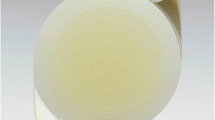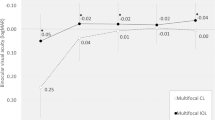Abstract
Purpose
To compare the patients’ visual results after bilateral implantation of the multifocal intraocular lenses (MIOLs): ReZoom (NXG1, Abbott Medical Optics, Abbott Park, IL, USA), Acrysof ReSTOR (SA60D3, Alcon Laboratories, Fort Worth, TX, USA) and Tecnis MF (ZM900, Abbott Medical Optics).
Materials and methods
A prospective, nonrandomized, comparative trial of 30 patients (60 eyes) aged 46–71 (mean age 56.3 ± 5.96) divided into three equal groups with implanted bilaterally multifocal lenses: ReZoom IOL, Acrysof ReSTOR IOL and Tecnis MF IOL. The patient selection criteria included no other eye disease besides cataract, and corneal astigmatism of 1.5 diopters or less. In each case, the patients were scheduled to have standard phacoemulsification surgery with IOL implantation into the bag. The postoperative target was emmetropia. The mean follow-up was 6 months in all eyes. The following parameters were assessed/carried out: slit-lamp examination, uncorrected and best spectacle-corrected far and near visual acuity, autorefractometry, intraocular pressure, contrast sensitivity and subjective satisfaction with vision using the VF-14 survey.
Results
After surgery, all eyes were within ±2.0D of target refraction. The mean uncorrected distance visual acuity improved in all cases. The postoperative BCDVA was better than 20/30 at the sixth month in all eyes. Six months postoperatively, the mean uncorrected distance visual acuity (UCDVA) ± standard error (SE) in the ReZoom, ReSTOR and Tecnis MF groups was 0.11 ± 0.01, 0.17 ± 0.02 and 0.14 ± 0.02 (LogMAR) respectively. All results were significantly better compared to preoperative values (p < 0.001) but did not differ between the study groups (p > 0.05). At the final visit, 75% of eyes in the ReZoom group achieved J1 (Jaeger standard) in comparison to 85% in the ReSTOR and Tecnis MF groups. Eighty percent of patients with bilaterally implanted ReSTOR and Tecnis MF IOL were spectacle-independent, in comparison to 70% with implanted ReZoom IOL. Thirty percent of patients with implanted Rezoom and Acrysof Restor IOL and 20% with implanted Tecnis multifocal IOL reported little or moderate halo and glare. The patients’ satisfaction after the procedure was excellent; the scoring on the VF-14 survey ranged from 70–100%, with an average of 93%. No patient was dissatisfied with the results of the surgery.
Conclusions
The implantation of tested multifocal intraocular lenses provides good near and distance visual acuity. We did not observe any statistically significant differences between the tested multifocal intraocular lenses with regard to best-corrected distance visual acuity, presence of glare and halo, as well as satisfaction with vision.





Similar content being viewed by others
References
Alió JL, Tavolato M, De la Hoz F, Claramonte P, Rodríguez-Prats JL, Galal A (2004) Near vision restoration with refractive lens exchange and pseudoaccommodating and multifocal refractive and diffractive intraocular lenses: comparative clinical study. J Cataract Refract Surg 30:2494–2503
Arnold PN (1994) Photic phenomena after phacoemulsification and posterior chamber lens implantation of various optic sizes. J Cataract Refract Surg 20:446–450
Blaylock JF, Si Z, Vickers C (2006) Visual and refractive status at different focal distances after implantation of the ReSTOR multifocal intraocular lens. J Cataract Refract Surg 32(9):1464–1473
Brenner MH, Curbow B, Javitt JC, Legro MW, Sommer A (1993) Vision change and quality of life in the elderly. Response to cataract surgery and treatment of other chronic ocular conditions. Arch Ophthalmol 111(5):680–685
Chiam PJ, Chan JH, Haider SI, Karia N, Kasaby H, Aggarwal RK (2007) Functional vision with bilateral ReZoom and ReSTOR intraocular lenses 6 months after cataract surgery. J Cataract Refract Surg 33(12):2057–2061
Dick HB, Krummenauer F, Schwenn O, Krist R, Pheiffer N (1999) Objective and subjective evaluation of photic phenomena after monofocal and multifocal intraocular lens implantation. Ophthalmology 106(10):1878–1886
Haaskjold E, Allen ED, Burton RL, Webber SK, Sandvig KU, Jyrkkiö H, Leite E, Liekfeld A, Philipson B, Nyström A, Wollensak J (1998) Contrast sensitivity after implantation of diffractive bifocal and monofocal intraocular lenses. J Cataract Refract Surg 24:653–658
Häring G, Dick HB, Krummenauer F, Weissmantel U, Kröncke W (2001) Subjective photic phenomena with refractive multifocal and monofocal intraocular lenses. Results of a multicenter questionnaire. J Cataract Refract Surg 27(2):245–249
Jacobi PC, Dietlein TS, Lüke C et al (2002) Multifocal intraocular lens implantation in prepresbyopic patients with unilateral cataract. Ophthalmology 109:680–686
Javitt JC, Brenner MH, Curbow B, Legro MW, Street DA (1993) Outcomes of cataract surgery. Improvement in visual acuity and subjective visual function after surgery in the first, second, and both eyes. Arch Ophthalmol 111:686–691
Javitt JC, Steinert RF (2000) Cataract extraction with multifocal intraocular lens implantation: a multinational clinical trial evaluating clinical, functional, and quality-of-life outcomes. Ophthalmology 107(11):2040–2048
Javitt JC, Wang F, Trentacost DJ, Rowe M, Tarantino N (1997) Outcomes of cataract extraction with multifocal intraocular lens implantation; functional status and quality of life. Ophthalmology 104(4):589–599
Montes-Mico R, Alio JL (2003) Distance and near contrast sensitivity function after multifocal intraocular lens implantation. J Cataract Refract Surg 29:703–711
Nida Sen H, Sarikkola AU, Uusitalo RJ, Laatikainen L (2004) Quality of vision after AMO Array multifocal intraocular lens implantation J Cataract Refract Surg 30(12):2483–2493
Pieh S, Weghaupt H, Skorpik C (1998) Contrast sensitivity and glare disability with diffractive and refractive multifocal intraocular lenses. J Cataract Refract Surg 24:659–662
Rosen PN, Kaplan RM, David K (2005) Measuring outcomes of cataract surgery using the Quality of Well-Being Scale and VF-14 Visual Function Index. J Cataract Refract Surg 31(2):369–378
Steinberg EP, Tielsch JM, Schein OD, Javitt JC, Sharkey P, Cassard SD, Legro MW, Diener-West M, Bass EB, Damiano AM et al (1994) The VF-14. An index of functional impairment in patients with cataract. Arch Ophthalmol 112:630–638
Tielsch JM, Steinberg EP, Cassard SD, Schein OD, Javitt JC, Legro MW, Bass EB, Sharkey P (1995) Preoperative functional expectations and postoperative outcomes among patients undergoing first eye cataract surgery. Arch Ophthalmol 113:1312–1318
Author information
Authors and Affiliations
Corresponding author
Rights and permissions
About this article
Cite this article
Gierek-Ciaciura, S., Cwalina, L., Bednarski, L. et al. A comparative clinical study of the visual results between three types of multifocal lenses. Graefes Arch Clin Exp Ophthalmol 248, 133–140 (2010). https://doi.org/10.1007/s00417-009-1177-4
Received:
Revised:
Accepted:
Published:
Issue Date:
DOI: https://doi.org/10.1007/s00417-009-1177-4




